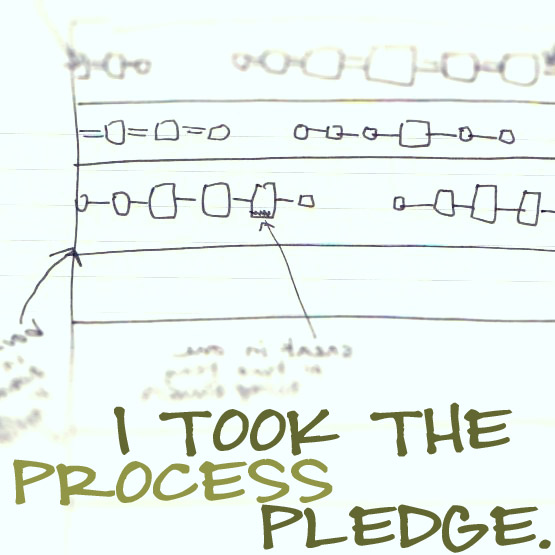my little faux crewel weekend project
Embroidery started as something I'd toyed with since childhood (sometime I should show you the flowers on the strap of my backpack from middle school...they're terrible but cute) and it has slowly but surely burgeoned into an obsession. Over time, it has simply become a way of life and there's not a week that goes by now when I'm not working on a personal piece or one for the shop.
Mostly, I've worked on modern line-based illustration pieces but I've been getting more and more interested in elaborate traditional styles and their history as an art form. There are so many areas to be explored but recently I've become quite enamoured with Jacobean crewelwork (and spent an entire night trying to convince my husband to move to southwest London so that I could start classes towards a foundation degree at the Royal School of Needlework...someday because now it's on my bucket list). I guess it's the art historian in me, but I love trying to discover the way in which different art forms have come into their own, the way each important piece establishes a dialogue between artists going back and forth throughout history, and how those pieces reflect on the continued development of the art form and the society that produces it.
Jacobean crewelwork initially interested me because it is so ornate and I love that it gives such priority to form and color—no surprise there if you've been following my work for a while. I also love that this type of embroidery is completely inseparable from the visual theme it has always played off of, known as the tree of life (which is also a religious and philosophical belief in the interconnectedness of all living things) wherein the highly stylized florals intertwine and are often accented by animals, vines, and leaves without a formalized single scale or perspective. You can recognize it in many Scandinavian and early American embroidered pieces (edit: as well as in medieval illuminated manuscripts and clothing of Elizabethan nobility when it was first developed as needlework inspired by flora and fauna from "The Orient," as it was then known) and I decided to base my first experiment (in the photos here) on a vintage piece from the 1970's which "riffed" off of the traditional motif but used much more modern and bright colors.
crewel embroidery experiment, detail
Since I had no crewel wool on hand or a pattern for that matter, I drew mine by "eyeballing" the vintage piece and substituted everyday canvas and cotton embroidery floss. I'm a firm believer in learning the "rules" for any art form so that you know how to break them with purpose and style down the road, but I was so excited, I just had to commit something to fabric right away, even if it was very simple and not at all authentic. I spent a good 8 hours completing this miniature work on a 3 inch embroidery hoop (thanks to watching one movie a night for three nights in a row) and have plans to incorporate it into a grouping of items going up our staircase that I want to hang salon style. Unfortunately, that kind of time commitment doesn't really make it something I could sell on etsy (darn you etsy and your constant undervaluing of handmade goods!), but I want to keep experimenting to see if there is a way I can do it because I really enjoyed it and feel it meshes well with the rest of my work while also being something new.
In the meantime, I'm definitely going to save up for some proper crewel wool and this fabulous looking book from the folks at RSN!






















10 comments:
Way cool... especially that you had no pattern, it looks awesome!
Looks fantastic Kat!!!
You'd fit right in with the Bennet sisters in Pride and Prejudice...sitting by the fire embroidering away!! ;-)
I learned so much from this post! I don't know very much about crewelwork - what is the difference from embroidery aside from the wool vs. cotton floss?
I'm loving your design!
thank you!
As far as I can tell, crewelwork is mostly distinguished by the woolen floss and by it's specific motif/subject matter. The technique differs somewhat in that the elaborate nature of the flowers require pieces to be worked from background to foreground and there are a lot of filled in areas whereas "free range" embroidery (my term) is much more open to interpretation. I'm discovering a lot of new stitches though in the process and found a great resource here: http://www.needlenthread.com/videos
p.s. it's also usually worked on linen. I found this description helpful: http://www.royal-needlework.org.uk/content/38/
so pretty!!
I absolutely love it!! You are indeed very talented. :)
Lovely take on Jacobean embroidery! I agree, this form of embroidery with its many colors, stitch varieties and specific designs... so beautiful!
I'm fond of most forms of free style (aka: traditional) and crewel embroidery.
Have you read about Erica Wilson? She is famous not only for her needlepoint but also for her crewel embroidery... although not Jacobean.
Wow, I do want to try something more historical like this someday. Your work is lovely. Lovely, lovely.
Oh! Yes !...but this is good and fun .You have brought this style right into our times with your colours . So joyful ! Love it ! Daisy Debs
Post a Comment